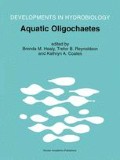Abstract
Eutrophic tidal flats and polluted coastal sites are the predominant habitat of the marine oligochaete Tubificoides benedii. The worms live in dense populations in these stressed habitats which are often characterized by high levels of hydrogen sulfide. This indicates that they have a high capacity to tolerate anoxic (and sulfidic) conditions. Respiration rates of T. benedii measured at various oxygen concentrations showed that aerobic respiration is maintained even at very low oxygen concentrations. This ability is combined with a high regulatory capacity of oxygen uptake. Addition of sulfide considerably reduced this capacity of maintaining aerobic metabolic pathways at low oxygen concentrations. The present work in relation to earlier physiological and structural studies (Giere et al, 1988; Dubilier et al., 1994, 1995, 1997) suggests adaptive strategies that make T. benedii one of the most successful inhabitants of ecologically stressed, sulfidic benthic environments. This is corroborated by comparison with other typical’ sulfide annelids’ such as the polychaetes Capitella capitata and Arenicola marina.
Access this chapter
Tax calculation will be finalised at checkout
Purchases are for personal use only
Preview
Unable to display preview. Download preview PDF.
References
Alsterberg, G., 1922. Die respiratorischen Mechanismen der Tubificiden. Lunds Univ. Årskr., N.F. Avd. 2, 18: 1–176.
Berg, K., P. M. Jónasson & K. W. Ockelmann, 1962. The respiration of some animals from the profundal zone of a lake. Hydrobiologia 19: 1–39.
Birtwell, I. K., 1972. Ecophysiological aspects of tubificids in the Thames Estuary. Ph.D. thesis, Univ. of London.
Birtwell, I. K. & D. R. Arthur, 1980. The ecology of tubificids in the Thames Estuary with particular reference to Tubifex costatus (Claparède). In R. O. Brinkhurst & D. G. Cook (eds), Aquatic Oligochaete Biology. Proceedings of the First International Symposium on Aquatic Oligochaete Biology. Sidney, B.C., Plenum Press, New York: 331–381.
Dahl, I. O., 1960. The oligochaete fauna of 3 Danish brackish water areas (taxonomic and biological observations). Meddr Kommn Danm. Fisk.-og Havunders. 2.: 1–20.
Degn, H. & B. Kristensen, 1981. Low sensitivity of Tubifex sp. respiration to hydrogen sulfide and other inhibitors. Comp. Biochem. Physiol. 69 B: 809–817.
Dubilier, N., O. Giere & M. K. Grieshaber, 1994. Concomitant effects of sulfide and hypoxia on the aerobic metabolism of the marine oligochaete Tubificoides benedii. J. exp. Zool. 269: 287–297.
Dubilier, N., O. Giere & M. K. Grieshaber, 1995. Morphological and ecophysiological adaptations of the marine oligochaete Tubificoides benedii to sulfidic environments. Am. Zool. 35: 163–173.
Dubilier, N., R. Windoffer, M. K. Grieshaber & O. Giere, 1997. Ultrastructure and anaerobic metabolism of mitochondria in the marine oligochaete Tubificoides benedii: effects of hypoxia and sulfide. Mar. Biol. 127: 637–645.
Duffy, J. E. & S. Tyler, 1984. Quantitative differences in mitochondrial ultrastructure of a thiobiotic and oxybiotic turbellarian. Mar. Biol. 83: 95–102.
Fenchel, T., 1996. Worm burrows and oxic microniches in marine sediments. 1. Spatial and temporal scales. Mar. Biol. 127: 289–295.
Gamenick, I., 1996. Ökophysiologische und enzymatische Differenzierung verschiedener Geschwisterarten des Capitella capitata-Komplexes (Annelida, Polychaeta). Shaker, Aachen: 112 pp.
Giere, O. & B. Rhode, 1987. Anatomy and ultrastructure of the marine oligochaete Tubificoides benedii (Tubificidae), with emphasis on its epidermis-cuticle complex. Hydrobiologia, 155, 159 (abstract).
Giere, O., B. Rhode & N. Dubilier, 1988. Structural peculiarities of the body wall of Tubificoides benedii (Oligochaeta) and possible relations to its life in sulphidic sediments. Zoomorphology 108: 29–39.
Grieshaber, M., 1992. Hypoxia and sulfide tolerance in some marine invertebrates. Hypoxie-und Sulfidtoleranz einiger mariner Invertebraten. Verh. dt. zool. Ges. 85: 55–76.
Grieshaber, M. K., I. Herdewig, U. Kreutzer & H.-O. Pörtner, 1994. Physiological and metabolic responses to hypoxia in invertebrates. Rev. Physiol. Biochem. Pharmacol. 125: 43–147.
Grieshaber, M. K. & S. Völkel, 1998. Animal adaptations for tolerance and exploitation of poisonous sulfide. Ann. Rev. Physiol. 60: 33–53.
Hauschild, K. & M. K. Grieshaber, 1997. Oxygen consumption and sulfide detoxification in the lugworm Arenicola marina (L.) at different ambient oxygen partial pressures and sulfide concentrations. J. comp. Physiol. B 167: 378–388.
Maguire, C. & P. J. S. Boaden, 1975. Energy and evolution in the thiobios: an extrapolation from the marine gastrotrich Thiodasys sterreri. Cah. Biol. mar. 16: 635–646.
Menon, J. G. & A. J. Arp, 1993. The integument of the marine echiuran worm Urechis caupo. Biol. Bull. 185: 440–454.
Menon, J. G., J. K. Willsie, A. Tauscher & A. J. Arp, 1995. Comparative ultrastructure of the epithelia of vestimentiferan tube worms from hydrocarbon seeps and deep-sea hydrothermal vents. Am. Zool. 35: 36A.
Oeschger, R. & R. D. Vetter, 1992. Sulfide detoxification and tolerance in Halicryptus spinulosus (Priapulida): a multiple strategy. Mar. Ecol. Prog. Ser. 86: 167–179.
Presser, C. L. & F. A. Jr. Brown, 1961. Comparative animal physiology. (2nd edn.). Saunders, Philadelphia, 688 pp.
Schneider, A., 1994. Die Sulfidtoleranz der Schlammröhrenwürmer Limnodrilus hoffmeisteri (Cl.) und Tubifex tubifex (M.). Shaker, Aachen: 122 pp.
Schüttler, U., B. Surholt & E. Zebe, 1984. Anaerobic metabolism in Arenicola marina and Nereis diversicolor during low tide. Mar. Biol. 81:69–73.
Thiermann, F., A.-S. Niemeyer & O. Giere, 1996. Variations in the sulfide regime and the distribution of macrofauna in an intertidal flat in the North Sea. Helgoländer Meeresunters. 50: 87–104.
Toulmond, A., 1975. Blood oxygen transport and metabolism of the confined lugworm Arenicola marina (L.). J. exp. Biol. 3: 647–660.
Völkel, S. & M. Grieshaber, 1997. Sulphide oxidation and oxidative phosphorylation in the mitochondria of the lugworm Arenicola marina. J. exp. Biol. 200: 83–92.
Author information
Authors and Affiliations
Editor information
Editors and Affiliations
Rights and permissions
Copyright information
© 1999 Springer Science+Business Media Dordrecht
About this paper
Cite this paper
Giere, O., Preusse, JH., Dubilier, N. (1999). Tubificoides benedii (Tubificidae, Oligochaeta) — a pioneer in hypoxic and sulfidic environments. An overview of adaptive pathways. In: Healy, B.M., Reynoldson, T.B., Coates, K.A. (eds) Aquatic Oligochaetes. Developments in Hydrobiology, vol 139. Springer, Dordrecht. https://doi.org/10.1007/978-94-011-4207-6_23
Download citation
DOI: https://doi.org/10.1007/978-94-011-4207-6_23
Publisher Name: Springer, Dordrecht
Print ISBN: 978-94-010-5829-2
Online ISBN: 978-94-011-4207-6
eBook Packages: Springer Book Archive

